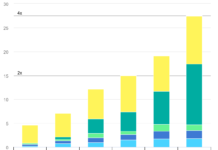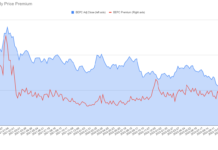by Debra Fiakas CFA
In the earlier post on Brightsource Energy and its Ivanpah solar thermal power plant in California cited costs for the plant as well as costs for nuclear and conventional power sources. A reader pointed out a discrepancy in those figures and it prompted me to look more closely at various sources and citations on power plant costs. Even within one design or fuel category, costs for power plants are exceptionally site specific. In particular variance can occur in labor, site preparation, and interconnection requirements. Certain material and equipment costs are more volatile than others. For example, high temperature- high-pressure pipe, electrical transformers and copper wire are high in demand in the oil and gas market as well as the power market. When both industries are busy, costs increase dramatically. So investors should expect quite a bit of variance across power sources and from region to region.
It is also easy to get tripped up in the power industry vernacular. (This is where the cart left the path in the earlier article.) Back in the 1700s when the steam engine was being perfected a smart Scotsman named Watt came up with a measure of energy conversion. The measure became standard and of course it had to be named after him.
Yet, one Watt is not enough. In very large power complexes, it becomes unwieldy to discuss power generation in terms of Watts. Here the Watt siblings come in handy to keep the digits at a reasonable number. You can choose Kilo’s or Mega’s or Giga’s. If a power plant has a capacity to produce 2,000,000,000 Watts and you want to shed all those zeros, you can choose among “2.0 billion watts” or “2,000 Megawatts” or “2.0 Gigawatts.”
| 1 Joule Per Second |
1 Watt |
| 1,000 Watts |
1 Kilowatt |
| 1,000,000 Watts |
1 Megawatt |
| 1,000,000,000 Watts |
1 Gigawatt |
Watts are standard, but the way we talk and write about them is not. The U.S. Energy Information Administration is among the most cited sources for Capital Cost Estimates for Utility Scale Electricity Generating Plants. This is probably because they have a fairly detailed report by that name. The report was most recently updated in April 2013 and expresses all costs per kilowatt. For example, the nuclear power plant cost is listed in the EIA report at US$5,533 per kilowatt.
The Nuclear Energy Agency also provides information on nuclear power plant construction costs, but uses megawatts as their basis. The NEA says “a typical cost for construction of a Generation III reactor between 1400 – 1800 MW in OECD countries might be in the region of USD 5 – 6 billion.”
Comparing the two sources requires some math. First, let’s get the average for that range of sizes and costs provided by the NEA.
| 1,400 Megawatts |
US$5 billion or US$5,000,000,000 |
US$3.6 million or US$3,571,429 per Megawatt |
| 1,800 Megawatts |
US$6 billion or US$6,000,000,000 |
US$3.3 million US$3,333,333 per Megawatt |
| Average 1,600 Megawatts |
US$5.5 billion or US$5,500,000,000 |
US$3.4 million or US$3,437,500 per Megawatt |
Now we need to either re-express the EIA numbers in Megawatts or the NEA numbers in Kilowatts to compare the two sets of numbers.
| |
Original Cost |
Equivalency |
Translation |
New Measure |
| EIA |
US$5,333 per Kilowatt |
1 Kilowatt = 0.001 Megawatts |
US$5,333 / 0.001 |
US$5,333,000 per Megawatt |
| |
|
|
|
|
| |
New Measure |
Equivalency |
Translation |
Original Cost |
| NEA |
US$3,438 per Kilowatt |
1 Megawatt = 1,000 Kilowatts |
US$3,437,500 / 1,000 |
US$3,437,500 per Megawatt |
That was exhausting. In the end, the two are so far apart as to bring into question the value of the cost benchmarks in the first place, from either source. Did I mention regional variances and how power generation costs can be quite site specific? It is also helpful to know that the EIA has recently updated it benchmark power plant costs, but the NEA’s numbers appear to be a bit older.
The EIA report on power plants cites costs for a collection of conventional fossil fuel plants. Natural gas power plants are among the fossil fuel-type power sources. The average is US$1,137 per kilowatt with a range of US$676 per kilowatt for an advanced conventional combustion turbine to US$2,095 per kilowatt for a conventional combustion plant outfitted with carbon capture technology. If fuel cells using natural gas were also included in this category, it would hold the dubious record as the most expensive at US$7,108 per kilowatt.
The EIA report also indicates a cost of US$5,067 per kilowatt for solar thermal power which we could have compared to our source for the cost of BrightSource’s Ivanpah power plant. It would have been a tip-off that the cost of US$5,500 per megawatt cited in the article on Brightsource was “off.” The Ivanpah facility has a capacity of 377 Megawatts and a cost of US$2.2 billion. That is a cost of US$5.8 million per megawatt or US$5,836 per kilowatt (since 1.0 Megwatt = 1,000 Kilowatts). Indeed, it appears there could be more to the discrepancy. The Brightsource website indicates the plant has a 377 megawatt capacity, but planned capacity is apparently 392 megawatts. Using 392 megawatts leads to a lower cost figure of US$5.5 million per megawatt.
For investors, the comparison of costs from one plant to another or even across categories has some informative value. Yet there are limitations. A resource poor region might find the construction of a nuclear facility compelling even if the cost per kilowatt is high in comparison to other energy sources. It is all relative. What is important for investors is whether future cash flows from the sale of electricity will be sufficient to allow investors to receive a return on their investment.
Debra Fiakas is the Managing Director of Crystal Equity Research, an alternative research resource on small capitalization companies in selected industries.
Neither the author of the Small Cap Strategist web log, Crystal Equity Research nor its affiliates have a beneficial interest in the companies mentioned herein.








